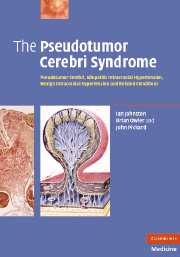 The Pseudotumor Cerebri Syndrome
The Pseudotumor Cerebri Syndrome Book contents
7 - Clinical investigations
Published online by Cambridge University Press: 21 August 2009
Summary
Introduction
The four basic objectives in the clinical investigation of PTCS may be enumerated as follows:
To establish the existence of raised CSF pressure
To evaluate its severity
To exclude other causes of raised CSF pressure, leaving PTCS as a diagnosis of exclusion as it has traditionally been
To identify any aetiological factors responsible for the PTCS
To these may be added investigations aimed at clarifying the mechanism of PTCS generally. Of course, these are not an essential component of the clinical investigation of a particular patient, a comment which also applies to some extent to the fourth category above.
The first category includes direct measurement of CSF pressure – either a single measurement by lumbar, cervical, cisternal or ventricular puncture, or continuous monitoring over a period of time from an intracranial or lumbar site – and fluorescein angiography as an ancillary and indirect method. The second category includes continuous CSF pressure monitoring again, as well as, more indirectly, neuro-ophthalmological evaluation, electroencephalography (EEG), and neuro-psychometric assessment. The third category includes analysis of CSF composition, and scanning methods, either CT or MR. The fourth category includes MR venography, DSA and venography, the latter with manometry, and detailed haematological analysis aimed at identifying thrombophilia and/or hypofibrinolysis. Investigations which at this stage are more or less limited to specialist centres are specialized MR techniques aimed at evaluating brain water content or CSF volume and dynamics, radionuclide studies of CSF dynamics, CSF infusion studies to quantitate resistance to CSF absorption, and metabolic or endocrine studies.
- Type
- Chapter
- Information
- The Pseudotumor Cerebri SyndromePseudotumor Cerebri, Idiopathic Intracranial Hypertension, Benign Intracranial Hypertension and Related Conditions, pp. 148 - 188Publisher: Cambridge University PressPrint publication year: 2007


